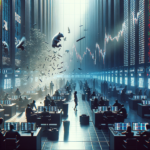Understanding the Underlying Factors of Market Instability Before the Flash Crash
Analysis: Market Instability Preceded Last Week’s Flash Crash
In the world of finance, stability is often a veneer that masks the turbulent undercurrents of the market. Last week’s flash crash was a stark reminder of this reality, as a sudden and severe drop in stock prices sent a shiver through the spines of investors around the globe. However, a closer examination of the events leading up to the crash reveals that the seeds of instability had been sown long before the market’s precipitous decline.
In the weeks preceding the crash, several indicators hinted at the fragility of the market. Volatility, often measured by the VIX index, had been creeping upward, suggesting that investors were growing increasingly nervous. This unease was not without merit; geopolitical tensions, whispers of inflation, and concerns over interest rate hikes had begun to erode the confidence that had buoyed markets for months.
Moreover, the market’s reliance on algorithmic trading systems has been a double-edged sword. While these systems can process information and execute trades with superhuman speed and efficiency, they can also amplify market movements. When the initial sell-off began, it’s likely that these algorithms kicked into high gear, selling off assets in a cascade that led to the flash crash.
Despite these challenges, it’s important to recognize that the market is more resilient than it may appear at first glance. In the aftermath of the crash, regulatory bodies and financial institutions have been quick to analyze the causes and implement measures to prevent similar occurrences in the future. This proactive approach is a testament to the market’s ability to learn from its missteps and strengthen its foundations.
Furthermore, the flash crash served as a wake-up call for many investors, reminding them of the importance of diversification and risk management. Those who had spread their investments across various asset classes and industries were less impacted by the crash, illustrating the wisdom of not putting all one’s eggs in one basket.
In addition, the rapid recovery of the market post-crash is a sign of underlying optimism. Investors are looking beyond the immediate turmoil and focusing on the long-term prospects of economic growth and corporate earnings. This forward-looking perspective is crucial in navigating the choppy waters of the stock market.
It’s also worth noting that the market’s infrastructure held up remarkably well during the crash. Trading platforms managed the surge in volume without significant technical issues, and the circuit breakers put in place after previous crashes performed their function, providing a much-needed pause for traders to regroup.
As we move forward, it’s clear that market instability is an inherent part of the financial landscape. However, by understanding the factors that contribute to such instability, investors can better prepare themselves for future fluctuations. The flash crash was a jarring event, but it also provided valuable lessons that can help fortify the market against similar events down the line.
In conclusion, while last week’s flash crash may have rattled investor confidence, it also highlighted the market’s capacity for resilience and adaptation. By taking stock of the underlying factors that led to the crash and learning from them, the financial community can foster a more stable and optimistic outlook for the future. After all, it is through understanding and overcoming challenges that progress is made, and the market is no exception to this rule.
Evaluating the Impact of Market Instability on Investor Confidence Post-Flash Crash
Analysis: Market Instability Preceded Last Week’s Flash Crash
In the wake of last week’s flash crash, a closer examination of the preceding market instability reveals a complex tapestry of factors that may have eroded investor confidence. Yet, despite the tumultuous events, there remains a silver lining as the market begins to show signs of resilience.
Prior to the sudden downturn, warning signals had been flashing in various sectors of the economy. Volatility indices had been creeping higher, suggesting that investors were bracing for potential disruptions. Additionally, geopolitical tensions and uncertainties around policy decisions had cast a shadow over the market’s usual optimism. These elements, combined with a highly leveraged trading environment, set the stage for the rapid sell-off that caught many by surprise.
The flash crash itself was a moment of intense market pressure, where prices plummeted within a very short time frame. This was exacerbated by algorithmic trading programs that, once triggered by certain market conditions, can accelerate the selling pressure. The speed and magnitude of the decline were enough to cause a temporary lapse in market liquidity, further fueling the downward spiral.
However, it’s important to note that the market’s infrastructure held up under the strain. Circuit breakers and other regulatory mechanisms functioned as intended, providing a much-needed pause in trading and helping to prevent a more severe crash. This swift response by regulatory systems is a testament to the lessons learned from past market disruptions and should offer some reassurance to investors that there are safeguards in place to mitigate such extreme events.
In the aftermath of the flash crash, investor confidence undoubtedly took a hit. The psychological impact of watching portfolio values decline rapidly cannot be understated. Yet, it is during these times of uncertainty that the market’s inherent resilience often begins to shine through. In the days following the crash, a sense of cautious optimism has started to emerge. Investors are beginning to look past the immediate shock and are considering the potential opportunities that such market dislocations can present.
Moreover, the market’s recovery efforts have been bolstered by a renewed focus on fundamental analysis. Investors are taking a more measured approach, seeking out companies with strong balance sheets, solid growth prospects, and sustainable business models. This return to fundamentals could help stabilize the market and restore confidence over the long term.
Furthermore, the flash crash has prompted a broader discussion about risk management and portfolio diversification. Investors are now more aware of the importance of having a well-constructed portfolio that can withstand market shocks. This heightened awareness is likely to lead to more prudent investment strategies, which could help prevent similar occurrences in the future.
In conclusion, while last week’s flash crash was a stark reminder of the market’s vulnerability to sudden shocks, it also highlighted the robustness of the financial system’s safeguards. As the dust settles, there is a growing sense of optimism that the market will not only recover but also emerge stronger. Investors are adapting, learning from the experience, and moving forward with a renewed appreciation for the dynamics of the market. The road ahead may still hold challenges, but the market’s ability to bounce back suggests a promising future for those who remain steadfast in their investment journey.







